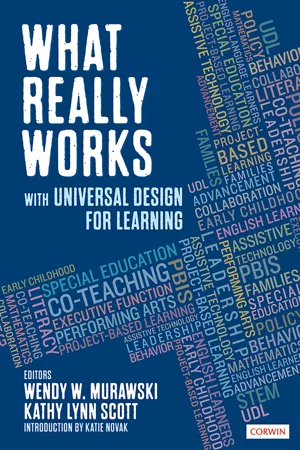
What Really Works With Universal Design for Learning
- 328 pages
- English
- ePUB (mobile friendly)
- Available on iOS & Android
What Really Works With Universal Design for Learning
About this book
Learn how to REALLY improve outcomes for all students
How do we remove learning barriers and provide all students with the opportunity to succeed? Written for both general and special educators from grades Pre-K through 12, What Really Works with Universal Design for Learning is the how-to guide for implementing aspects of Universal Design Learning (UDL) to help every student be successful. UDL is the design and delivery of curriculum and instruction to meet the needs of all learners by providing them with choices for what and why they are learning and how they will share what they have learned. Calling on a wide-range of expert educators, this resource features
- An unprecedented breadth of UDL topics, including multiple content areas, pedagogical issues, and other critical topics like executive function, PBIS, and EBD
- Reproducible research-based, field-tested tools
- Practical strategies that are low cost, time efficient, and easy to implement
- Practices for developing shared leadership and for working with families
Educators want to see each and every student succeed. This teacher-friendly, hands-on resource shows how UDL can be used to build the flexibility required to meet students' strengths and needs without overwhelming teachers in the process
Frequently asked questions
- Essential is ideal for learners and professionals who enjoy exploring a wide range of subjects. Access the Essential Library with 800,000+ trusted titles and best-sellers across business, personal growth, and the humanities. Includes unlimited reading time and Standard Read Aloud voice.
- Complete: Perfect for advanced learners and researchers needing full, unrestricted access. Unlock 1.4M+ books across hundreds of subjects, including academic and specialized titles. The Complete Plan also includes advanced features like Premium Read Aloud and Research Assistant.
Please note we cannot support devices running on iOS 13 and Android 7 or earlier. Learn more about using the app.
Information
1 UDL and Literacy: Providing Options for Language Success
Setting the Stage for UDL and Literacy
Putting UDL and Literacy Into Practice: Representation
Perception
Tech Tip
- The ASL app
- Lifeprint.com
- Signingsavvy.com
- YouTube!
- Signingtime.com
- USE VARYING APPROACHES TO DEVELOP FLUENCY when reading various texts (e.g., voice inflection to demonstrate emotions). Prosody, tone, and rate of speech are also important when teaching fluency. Students can record themselves to self-evaluate or peer-evaluate fluency based on the above characteristics.
- INCORPORATE AMERICAN SIGN LANGUAGE (ASL) for students to practice spelling or vocabulary words. It will reinforce English language skills while introducing a new language that will include students who sign as their primary language.
- UTILIZE TEXT FEATURES and other visuals such as charts and graphs to emphasize points. Allow students to use text features in their work, too, rather than requiring only narrative descriptions. Digital versions also allow for enlargement of text, enhancing details of pictures, or text-to-voice. You may even want to introduce the “Accessibility” features on most smartphones. Many individuals do not even know they are there!
- INCORPORATE THE SENSES when appropriate. Using a variety of senses to help with description, narrative, characterization, and perception can make work far more interesting. Use a variety of lighting, fidgets, and seating with varying textures, or aromatherapy during writer’s workshop or independent reading to help students engage more of their senses.
Language and Symbols
- CREATE A WORD WALL FOR PERTINENT VOCABULARY in which students take turns writing the word and representing the word graphica...
Table of contents
- Cover
- Half Title
- Acknowledgements
- Title Page
- Copyright Page
- Contents
- Preface
- About the Editors
- About the Contributors
- UDL: An Introduction From Pizza Parlor to the World
- SECTION I What Really Works With Content Areas
- 1 UDL and Literacy: Providing Options for Language Success
- 2 UDL and Mathematics: Making Algebra Accessible
- 3 UDL and Social Studies: Applying Project-Based Learning
- 4 UDL and Science: Integrating STEM
- 5 UDL and the Performing Arts: Inspiring Creativity
- SECTION II What Really Works With Behavior
- 6 UDL and Executive Functioning: Unlocking the Capacity for Learning
- 7 UDL and Positive Behavioral Interventions and Supports: Making Classroom Management Positive
- 8 UDL and Adaptive Behavior: Addressing Conceptual, Social, and Practical Skills
- SECTION III What Really Works With Instruction
- 9 UDL and Co-Teaching: Establishing the Perfect Union
- 10 UDL and Assistive Technology: Utilizing Technology Beyond Mere Accessibility
- 11 UDL and Implementation Fidelity: Providing Consistency Within Flexibility
- SECTION IV What Really Works With Special Populations
- 12 UDL for Advancement: Unblocking the Traffic Jam
- 13 UDL and Early Childhood: Giving Young Children Choices Too
- 14 UDL and Students With Emotional/Behavioral Disorders: Promoting Self-Managers
- SECTION V What Really Works Beyond the Classroom
- 15 UDL and Administrators: Leading the Charge
- 16 UDL and Home School Collaboration: Partnering for Empowerment
- 17 UDL and Policy: Considering Legal Implications
- 18 UDL and Change: Taking Baby Steps to Success
- Index
- Advertisement